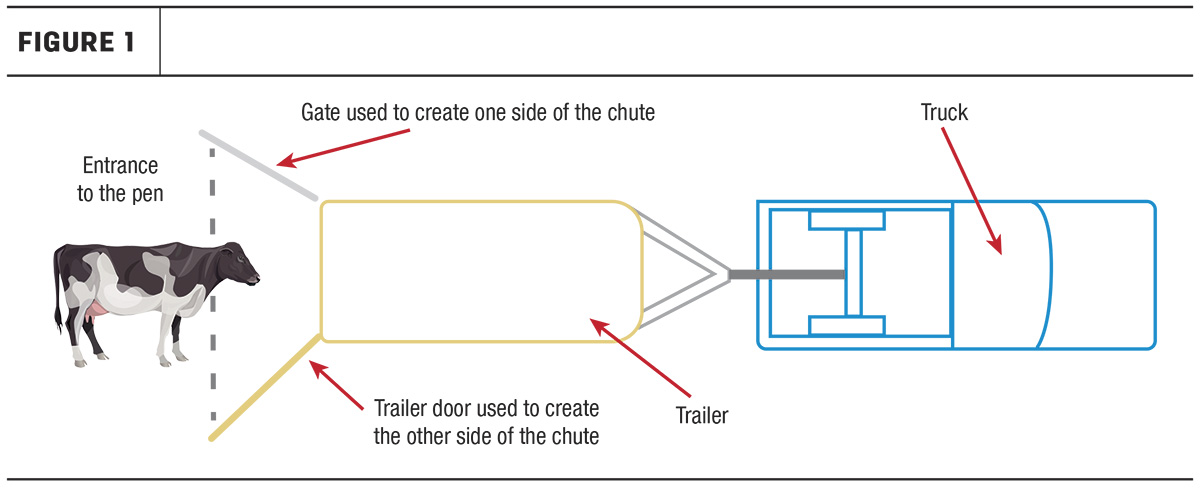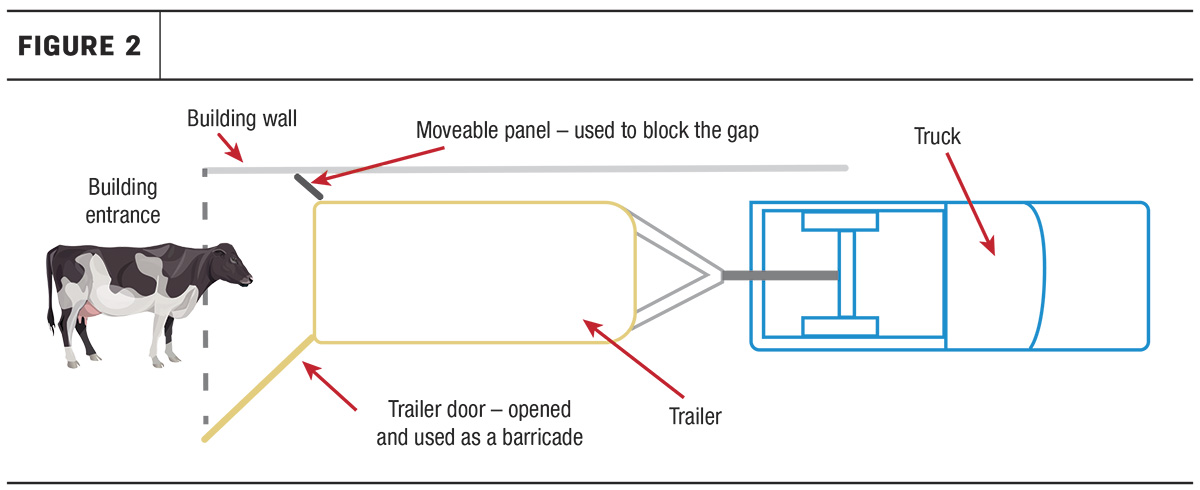To read this article in French, click here.
Loading cows onto a trailer can be a tricky and stressful task. The conditions can vary greatly depending on where this is done and what the circumstances are for loading the animals. We understand that every farm is set up differently and may have different loading areas and equipment to use when loading cows onto a trailer.
There is often a lot of conversation regarding loading cattle from the cattle perspective, and this is certainly important information to consider, but it is also important to keep the safety of the animal handlers top of mind as well. It is extremely important to ensure animal handlers are trained in proper loading and unloading practices and understand how to protect their own personal safety during the loading and unloading process. Proper planning is essential to ensure the safety of the cows and the animal handlers.
When preparing to load cows, there are many factors that must be considered, including the trailer being used, any equipment or tools being used, the location for loading/unloading, and the experience and understanding of the animal handlers. Consider the following safety practices before you begin loading/unloading.
Trailer and equipment
- Ensure the equipment and trailer being used are appropriate for the type and size of animals being loaded. Make sure you have all needed items/equipment handy before you start the process.
- Consider the height of the trailer, and try to have the loading area as low to the ground as possible to reduce the amount that the animal has to jump onto the trailer. Use a ramp where necessary.
- Follow all safety procedures when connecting and disconnecting trailers. Trailers must be properly connected and locked in place before you begin loading. Spotters must stand out of the path of travel.
Location for loading/unloading
- Ensure you have a safe location for loading/unloading. Make sure the path is clean and clear of distractions and obtrusions and the loading/unloading area is not slippery. Ensure adequate lighting.
- Make sure that all gates and doors in the area are properly secured to ensure that other animals cannot enter the loading area.
- Back up the trailer so the entrance onto the trailer is as close to the loading area as possible.
- Make sure the trailer is positioned so the animals do not have an escape route. This means blocking off any potential escape routes or gaps on the way to the trailer. This should be done by using components of the existing structures in the area or moveable barricades to block escape routes. Do not use a person to block the escape route.
- Where possible, ensure cows are not stressed by their current conditions prior to loading. Where possible, have cows in a comfortable location for a period of time prior to loading.
Animal handlers
- Ensure you plan the load before beginning. Be prepared for unexpected behaviour by the animals.
- Ensure everyone in the area remains calm and alert throughout the process.
- Always remain in a position where you are not at risk of being kicked or trampled. Do not stand in the animal’s blind spot or apply pressure in a way that may cause the animal to kick.
- Make sure that anyone in the area has at least two escape routes at any point in time and is able to get out of the way of the cow if they begin to act erratically.
- The task of loading/unloading should be completed by at least two trained animal handlers.
- If loading multiple animals into a trailer, you must remain aware of all of the animals in the area.
- Use extra caution around gates in the trailer; if an animal backs into a gate, it can spring toward you.
- Once you have loaded the animals, close the back gate as quickly as possible. Stand to the side and ensure the gate is latched correctly and secured.
- Keep fingers and other body parts away from pinch and crush points on the gates and doors.
Loading cows onto a trailer
When possible, you should create a guiding chute by backing up to a pen or gated area and using the gate to create one side of the chute and the open trailer door to create the other side of the chute. (See Figure 1.)

If you are not able to back directly up to the gate and use the trailer door/gate combination, try to use the doors of the trailer along with other structural components to create a chute into the trailer – this may include the walls of the building, doors or cattle panels. If you are unable to use the existing structure, doors and gates to create a guiding chute, you should use secondary barricades such as cattle panels or moveable gates to direct the cows into the trailer. (See Figure 2.) Make sure there are no gaps or areas where cows can escape through. Remember, do not to use a person to block gaps or escape routes.

Where possible, secure moveable gates, panels or other barricades to the side of the trailer to ensure cows cannot get through any potential escape routes. Ensure portable barricades, panels or gates cannot fall on any animals or people. Remember, anyone in the area must ensure they have two escape routes for themselves, and do not stand in front of a fixed object or in an area where you could be pinned or crushed.
Where possible, allow the cows to just walk directly onto the trailer. Do not push cows into the trailer. Do not get angry or aggressive toward the cows. You should drive the cows into the trailer in a way that clearly communicates to them what you want. Use a zig-zag technique, which cows willingly move away from. The zig-zag also prevents you from falling in directly behind and getting into animals’ blind spots.
If they do not walk directly onto the trailer, use the doors, gates, cattle panels or other barricades to slowly shrink the space around them and guide them onto the trailer.
Once the cows are loaded, close the trailer doors. Be careful not to close the door on their legs. Be aware of the possibility of cows kicking the door while it is being closed. Stand to the side of the trailer door when closing.
Loading with a lead line
If loading with a lead line, you should step up into the trailer before the animal. Do not try to force or rush the animal into the trailer. Ensure animals are tied in the correct position according to the type of trailer you have. For a bumper pull trailer, you must have the heaviest weight distribution in front of the axles.
Tie the lead line up high with a slipknot so you can untie it easily when needed. When you walk out, make sure the cow is not able to kick you, and step away from the animal quietly.
If loading additional cows and when unloading, ensure cows are aware that you are in the trailer and see you before you approach them. Turn the animal around where possible so they do not step on your feet. When unloading, step off the trailer before the cow, and step as far away from the trailer entrance as possible to allow the cow to jump off. Ensure you pull the lead slowly and away from you when getting the cow off the trailer.
In conclusion, every farm and every situation may be a bit different, but at the end of the day, it is important to be prepared and ensure that anyone involved in loading or unloading cattle has a good understanding of the safety measures that need to be taken.









